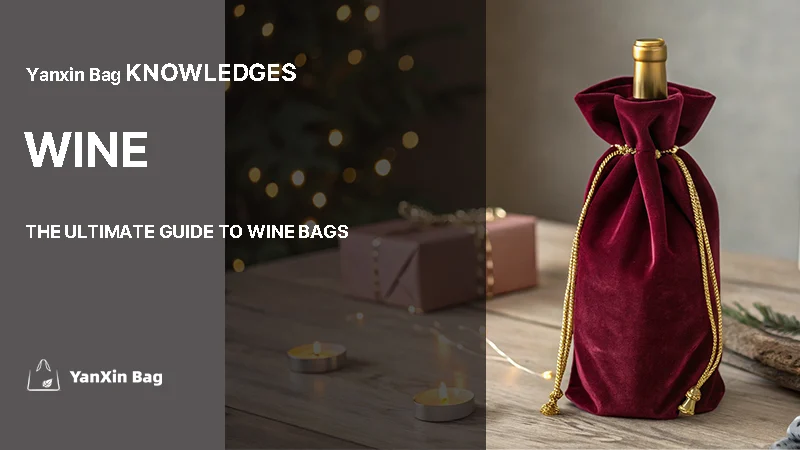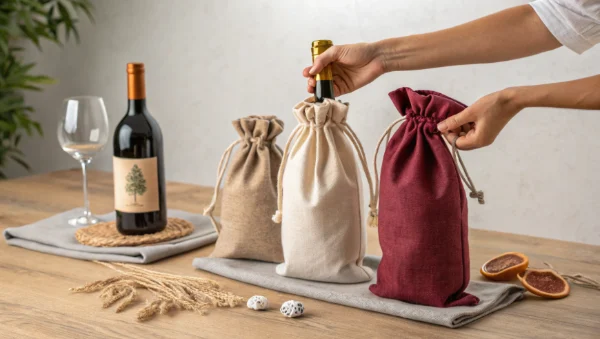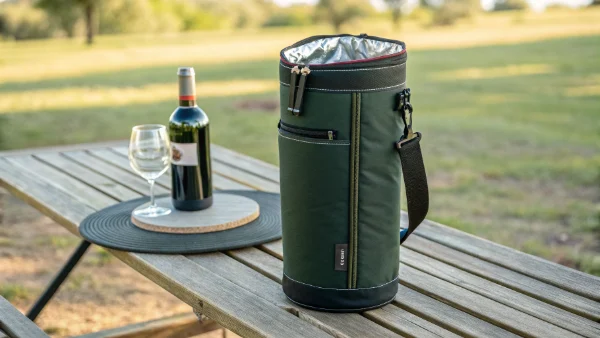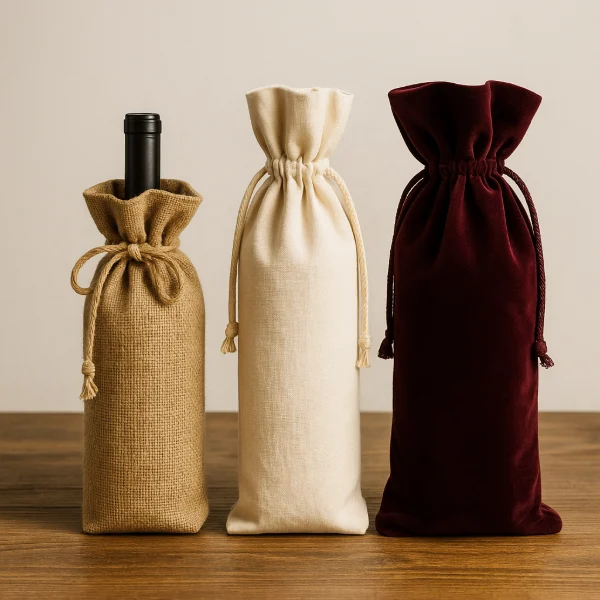
There’s a wide range of wine bags available on the market—from elegant gift bags to practical insulated carriers—each designed with different uses and features in mind. To help you choose the right one, this guide will walk you through the various types, materials, and usage scenarios of wine bags.
So what kinds of wine bags are out there—and how do you choose? The most common options include gift bags, reusable totes, insulated bags, multi-bottle carriers, and fully customized designs. Gift bags are typically used for personal or festive gifting, and are often made from paper or fabric. Reusable totes are great for retail packaging and promotional use, offering long-term value. Insulated wine bags help maintain temperature during transport or outdoor use. Multi-bottle carriers come with built-in dividers to keep bottles separate and secure. Custom designs are ideal for brand marketing or commemorative events. When choosing a wine bag, you’ll want to consider factors like usage scenario, preferred materials (such as jute, canvas, or velvet), whether insulation or protection is needed, carrying capacity, overall appearance, and budget.
Wine bags may look simple at first glance, but they actually vary a lot in style, material, and function. To help you better understand what makes each type unique—and how to choose the one that fits your needs—we’ll break everything down step by step. From structural designs to practical use cases and customization tips, this guide covers it all.

In both consumer and business settings, wine bags play a practical yet aesthetic role—whether it’s for holiday gifting, event merchandising, or everyday convenience. For businesses, they also offer a low-cost and customizable way to showcase brand identity in a tangible and memorable form.
Protective Cushioning
Many wine bags are made with sturdy materials or inner padding to help prevent bottle breakage during transport or handling, offering added safety and peace of mind.
Brand Visibility
Customizable with logos, patterns, or seasonal graphics, wine bags serve as an effective way to increase brand recognition and enhance your visual identity.
Temperature Control & Portability
Some wine bags come with insulated linings, making them ideal for outdoor events or longer trips where maintaining the right temperature is important.
Reusable Value
Unlike single-use packaging, fabric and laminated wine bags can be reused multiple times—offering better cost-efficiency and longer brand exposure.
Eco-Friendly Appeal
Materials like jute, washable kraft paper, and RPET help reduce plastic waste and support sustainable sourcing, aligning with eco-conscious business practices.
Enhanced Gifting Experience
Details like drawstring closures, satin ribbons, or velvet textures elevate the look and feel of the packaging—making any wine gift more thoughtful and memorable.

Choosing a wine bag with dividers helps protect multiple bottles during transport. True
Dividers prevent bottles from colliding, making multi-bottle bags safer for transport and display.
Wine bags made from Tyvek are completely biodegradable. False
Tyvek is made from HDPE, which is recyclable but not biodegradable.
Gift wine bags are designed to create a strong visual impact and enhance the gifting experience. Commonly used for holidays, weddings, gift baskets, or e-commerce packaging, these bags are usually made for single bottles and feature a simple structure. They can be accessorized with drawstrings, satin ribbons, or gift tags to create a “surprise upon opening” effect.
They’re ideal for one-time use in consumer-facing settings where presentation matters. Popular materials include paper, jute, linen-like fabric, cotton canvas, and velvet—each adding its own festive or premium touch.
Reusable wine totes focus on functionality and brand visibility, making them a smart choice for supermarkets, trade shows, corporate giveaways, and other commercial use cases. They are often customized with logos and built for repeated use, turning each bag into a mobile branding tool.
Available in single, double, four-bottle, or even six-bottle formats, these bags often include added features like dividers, reinforced bottoms, or sturdy handles to improve carrying capacity and convenience. Commonly made from laminated non-woven, laminated RPET, or other coated fabrics, they offer excellent durability and long-term value.
Insulated wine carriers offer basic thermal protection, water resistance, and shock absorption, making them suitable for short-term chilling and transport. They’re often used for outdoor picnics, holiday gatherings, or as part of premium gift sets. Most styles are tall and slim to fit standard wine bottles, unlike bulkier beer coolers.
Typical sizes include one, two, or four-bottle options. Some models come with shoulder straps, padded dividers, or outer pockets for added convenience. These bags are often made from composite materials such as Oxford fabric or neoprene, with structured exteriors and aluminum-lined, foam-insulated interiors.
If you’re more interested in drawstring wine gift bags for festive occasions, feel free to check out our dedicated guide: Choosing the Best Drawstring Wine Gift Bags.
In addition to differences in use or materials, wine bag structures also impact functionality and customization options. Here are some of the most common structural types:
This is the standard format for most gift and display bags. Typically cylindrical in shape, it helps highlight the wine bottle’s form. Commonly seen in paper bags, velvet pouches, and Tyvek bags.
Often made to hold two or four bottles, this structure usually includes built-in dividers. Ideal for wine sets, family shopping, or corporate gifting. Some models feature reinforced handles or covers to enhance load-bearing and protection.
Whether for two or six bottles, internal dividers help prevent bottles from bumping into each other. This design is often used in cotton, laminated materials, or Oxford fabric wine bags.
Some wine bags offer enhanced features like backpack-style carrying or built-in wine glass holders for picnics. These are popular in high-end branding, travel gifting, or outdoor retail scenarios.

Choosing the right material for your wine bag affects not only the look and feel but also durability, water resistance, print compatibility, and customization flexibility. Here’s a comparison of commonly used materials in the market:
| Material | Key Features |
|---|---|
| Jute | Features a natural fiber texture with a coarse and stiff feel, ideal for a rustic, eco-friendly look. Can be paired with a PVC window for added visibility. |
| Cotton / Canvas | Soft to the touch and durable, supports a wide range of colors and printing methods—ideal for versatile customization. |
| Velvet | Smooth, glossy, and drapey with a luxurious feel. Comes in rich colors and is often used for upscale presentation. |
| Tyvek | Extremely lightweight, water-resistant, and tear-resistant. Its paper-like surface gives it a unique texture for modern, creative designs. |
| Washable Kraft Paper | Paper-like appearance with stiffness and moderate flexibility. Water-resistant and washable, suitable for sustainable reuse. |
| Laminated Non-Woven / RPET / PP Woven | Laminated surface makes it sturdy, water-resistant, and durable—ideal for structured, large-volume bags with high customization needs. |
| Non-Woven | Lightweight, cost-effective, and available in a wide range of colors. Easy to shape and commonly used for promotional bags. |
| Paper | Lightweight and printable with colorful designs or foil stamping. Mostly used for disposable gift packaging. |
Clarifying the intended use is the first step in selecting a wine bag—whether it’s for gift-giving (such as weddings or holiday presents), brand events (like trade shows or corporate giveaways), or retail packaging (for supermarkets or wineries). Each scenario comes with different requirements for appearance, cost, structure, and printing.

Choosing a slightly shorter wine bag can enhance its gift-like appearance. True
A bag that cinches at the bottle neck and reveals part of the cap creates a more intentional and elegant presentation.
Velvet wine bags are only suitable for winter holidays. False
While velvet pairs well with festive seasons, it can also be used for luxury gifts and business events throughout the year.
Material plays a key role in determining both the visual style and unit cost. Jute works well for a natural, rustic look. Laminated fabrics offer good durability at a lower cost. Velvet delivers a more premium, festive feel. Aligning the material with your budget and brand identity is essential to achieving the right presentation.
If the bag is meant for outdoor use or temperature control—such as picnics or travel—consider insulated bags with foam or aluminum lining. For general transport or display, a basic structure is usually sufficient.
A wine bag can serve as an effective brand touchpoint. Will you add your logo? Do you need custom features like drawstrings, ribbons, or buttons? What about inner dividers or add-on details? These design elements help enhance both brand visibility and packaging appeal.
For business buyers, a wine bag is more than just packaging—it’s an extension of your brand. When customizing wine bags for bulk orders, it’s important to look beyond materials and structure, and pay attention to key details like printing methods, order process, and logistics. These factors play a major role in ensuring cost efficiency and timely delivery.
Here are the most common customization elements we support:
Size & Structure: Choose from single-bottle, double, four-bottle, or six-bottle formats based on your wine packaging needs. Reinforced bases, dividers, and sturdy handles can be added for better support.
Material Choices: We offer a wide range of materials such as jute, velvet, Tyvek, and laminated fabrics to suit different brand styles and durability requirements.
Printing Options: Available techniques include screen printing, heat transfer, foil stamping, and UV printing—each suitable for different artwork complexities and budgets.
Accessories & Add-ons: Enhance the bag’s appearance and function with drawstrings, ribbons, Velcro closures, hang tags, or PVC windows.
Minimum Order Quantity (MOQ): Most materials require a minimum of 500–1000 units. The more you order, the lower the cost per unit.
Sampling Recommendation: We strongly recommend requesting a sample before confirming the full order—especially for complex structures or detailed printing—to ensure accuracy.
Design File Requirements: Please prepare vector-based artwork (AI or PDF). Be sure to specify bleed size, print area, and color mode (CMYK or Pantone) for production.
Shipping Options: For large quantities, consolidated production and sea shipping offer the best value. If your timeline is tight, we can arrange partial air freight as needed.
Packaging Advice: For multi-bottle bags, we recommend reinforced cartons and internal separators to prevent damage during transport.
Estimated Lead Time: Samples typically take 5–7 days. Bulk production requires 15–30 days depending on material and order size.
We suggest working with a supplier experienced in wine bag manufacturing. Key factors to consider include: ability to provide samples, flexible MOQs, reliable delivery schedules, and smooth communication throughout the process. These elements are crucial to a successful custom order.
Insulated wine bags are useful for maintaining temperature during picnics or transport. True
They typically include foam and foil layers to help retain cold or moderate temperatures for short periods.
All drawstring wine bags come with inner waterproof linings. False
Most drawstring wine bags do not include inner linings; they rely on the outer fabric alone for structure and presentation.
If you’re looking for a custom wine bag manufacturer, Yanxin Bag is a reliable partner you can count on. We specialize in a wide range of wine bag styles—jute, velvet, Tyvek, laminated materials and more—offering full customization on size, structure, printing, and accessories. Whether for brand promotion, seasonal gifting, or retail packaging, we provide quality-driven solutions that balance style and cost.
Contact Yanxin Bag today, your trusted wine bag factory, to get a free sample consultation and start customizing wine bags that truly elevate your brand.
1Learn about the advantages of multi-bottle insulated carriers, perfect for keeping your wine at the right temperature during transport.
2Learn about the advantages of functional insulated carriers to ensure your wine stays perfectly chilled or at the right temperature.
3Learn effective strategies to simplify your packaging customization, ensuring a smooth and efficient experience.
Answer: Common types of wine bags include gift wine bags, reusable wine totes, and insulated wine carriers. Each is designed for different occasions, such as festive gifting, brand promotions, or outdoor transportation.
Answer: Businesses can customize wine bags in terms of size, structure, materials (such as jute, velvet, Tyvek, or laminated fabrics), printing methods (like screen printing, foil stamping), and accessories like ribbons, hangtags, or PVC windows.
Answer: Wine bags support various printing methods including screen printing, heat transfer, UV printing, and foil stamping. These are ideal for showcasing brand logos, festive graphics, or personalized text.
Answer: Popular eco-friendly wine bag materials include jute, washable kraft paper, RPET (recycled PET), and cotton. These materials offer reusability, biodegradability, or recycled content—making them suitable for green packaging initiatives.
Answer: Tyvek wine bags are lightweight, water-resistant, and tear-resistant. They are ideal for creative gift packaging or ecommerce brands that seek both functionality and a unique appearance.
Answer: Yes. Insulated wine bags typically feature foam padding and aluminum foil lining, helping maintain the ideal temperature for wine or champagne during short-term transport or outdoor events.
Answer: Wine bags are widely used in winery retail, festive gift sets, ecommerce packaging, wedding favors, and corporate giveaways. They offer both practicality and brand exposure.
Answer: Look for a custom wine bag manufacturer with proven experience, low MOQ flexibility, sample support, fast turnaround times, and clear communication. These factors ensure smooth order execution and consistent quality.
Answer: Store in a dry, well-ventilated area away from moisture. For fabrics like cotton, velvet, or linen, ensure the bags are cleaned and air-dried before storing to prevent odor or mildew.

Order or no-order we are Always here to help you!
We will contact you within 1 working day, please pay attention to the email with the suffix “@yanxinbag.com”.
Order or no-order we are Always here to help you!
We will contact you within 1 working day, please pay attention to the email with the suffix “@yanxinbag.com”.